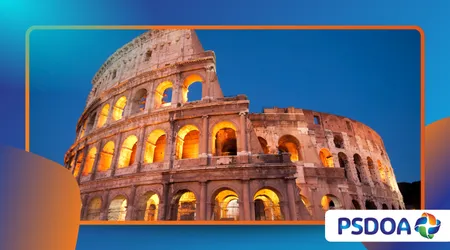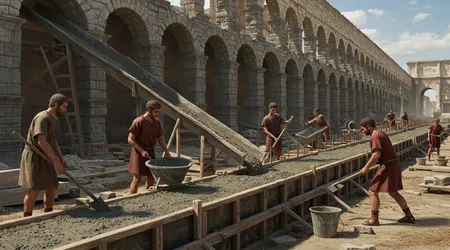Roman Concrete: How Ancient Builders Created Structures That Lasted Millennia

Roman concrete, a marvel of ancient engineering, transformed architecture with its unmatched durability. Unlike modern materials, it withstood time, weathering, and seismic shifts.
Anúncios
The Romans, master builders of antiquity, crafted structures like the Colosseum and aqueducts that remain standing after two millennia.
This article explores the genius of Roman concrete, unraveling its composition, innovative techniques, and lessons for today’s world. Why did their concrete endure while modern structures often crumble? Let’s dive into this forgotten invention, blending history, science, and modern relevance.
The allure of Roman concrete lies in its ability to defy decay. Structures like the Pantheon, with its massive unreinforced dome, showcase its strength.
Built around 126 CE, the Pantheon’s dome remains the largest of its kind. The secret? A unique blend of volcanic ash, lime, and aggregate.
Anúncios
This article will dissect Roman concrete’s composition, its construction methods, environmental resilience, and its potential to inspire sustainable modern building practices. Join us as we uncover why this ancient technology still captivates engineers and architects in 2025.
The Composition of Roman Concrete: A Recipe Lost and Rediscovered
The brilliance of Roman concrete begins with its ingredients. Volcanic ash, or pozzolana, sourced from regions like Pozzuoli, reacted with lime to form a robust binder.
Unlike modern Portland cement, this mixture gained strength over time. A 2017 study by the University of Utah revealed that seawater exposure triggered chemical reactions, forming aluminous tobermorite, a mineral that enhanced durability. This self-healing property allowed Roman concrete to repair cracks naturally.
Pozzolana’s role was pivotal. Mixed with lime and volcanic rock, it created a mortar resistant to water and stress. The Romans varied aggregate sizes, using lighter pumice for upper structures and heavier basalt for foundations. This strategic layering reduced weight while maintaining stability.
++ Forgotten Monorail Designs That Were Way Ahead of Their Time
The Colosseum’s ability to endure earthquakes underscores this ingenuity. Modern concrete, reliant on steel reinforcement, often corrodes within decades, whereas Roman concrete thrives without metal.
Imagine a cake that gets tastier with age that’s Roman concrete. Its chemical evolution ensured longevity, unlike modern concrete’s static nature. The Romans didn’t just build; they engineered for eternity.
Their intuitive grasp of material science, without modern tools, humbles today’s engineers. Could we replicate this alchemy? The rediscovery of pozzolana’s properties in recent studies suggests we’re close, but scaling it remains a challenge.

Construction Techniques: Precision in an Age Without Machines
Roman builders lacked cranes or computers, yet their methods were surgical. They mixed Roman concrete on-site, pouring it into wooden molds with meticulous care. These molds, often reused, allowed for rapid construction of arches and vaults.
The aqueducts, like Portugal’s Aqueduto das Águas Livres, demonstrate this precision, spanning kilometers with minimal gradient errors. Their concrete set underwater, a feat modern builders still marvel at.
Layering was key. Romans alternated Roman concrete with brick or stone facings, creating composite structures that distributed stress evenly. This technique, seen in the Baths of Caracalla, minimized cracking.
Also read: The Mechanical TV: How Moving Discs Almost Became the Norm
They also used lightweight aggregates in domes, reducing structural load. A 2023 analysis by MIT showed that Roman builders adjusted concrete density intuitively, optimizing each project’s needs without formal calculations.
Think of Roman construction as a symphony each element played a role, harmonizing strength and flexibility. Their hands-on approach contrasted with today’s reliance on machinery.
By pouring concrete in thin, successive layers, they ensured uniformity. This forgotten craft challenges modern assumptions about efficiency. Could we blend their tactile wisdom with today’s technology? The answer lies in rediscovering their balance of art and science.
Environmental Resilience: Why Roman Concrete Endures
Roman concrete’s environmental resilience is legendary. Structures like the Port of Caesarea, submerged for centuries, remain intact despite relentless waves.
The secret lies in its chemical stability. Seawater, rather than eroding Roman concrete, strengthened it through mineral growth. A 2024 study by the European Journal of Materials Science confirmed that tobermorite crystals formed in marine environments, sealing micro-cracks.
This resilience contrasts sharply with modern concrete. Portland cement degrades in saltwater, with steel reinforcements rusting within 50 years. Roman structures, free of metal, avoided corrosion entirely.
Their concrete’s low carbon footprint also stands out pozzolana required minimal processing compared to energy-intensive cement production. In 2025, as sustainability drives construction, Roman concrete offers a blueprint for eco-friendly building.
Read more: Edison’s Concrete House: A Vision for Cheap, Durable Homes
Picture a fortress laughing at time’s assaults that’s Roman concrete. Its ability to thrive in harsh conditions humbles modern materials. The Romans unknowingly pioneered green engineering, using local resources efficiently.
Today’s push for net-zero construction could learn from this. Why not harness volcanic ash again? The challenge is logistical, but the potential for durable, sustainable structures is undeniable.
Modern Applications: Reviving Roman Concrete in 2025
The rediscovery of Roman concrete sparks excitement in 2025. Engineers are testing pozzolana-based mixes for sustainable infrastructure.
A California pilot project, launched in 2024, uses volcanic ash in bridge construction, showing 30% less carbon emissions than traditional methods. The table below highlights key differences between Roman concrete and modern concrete:
| Property | Roman Concrete | Modern Concrete |
|---|---|---|
| Main Binder | Pozzolana and lime | Portland cement |
| Durability | Millennia (self-healing) | Decades (prone to corrosion) |
| Carbon Footprint | Low (natural materials) | High (energy-intensive production) |
| Water Resistance | Excellent (marine environments) | Poor (corrodes with saltwater) |
This revival isn’t just academic. Coastal cities, battered by rising seas, could benefit from Roman concrete’s marine resilience. Imagine a seawall in Miami, built with pozzolana, outlasting storms for centuries.
Yet, challenges remain sourcing volcanic ash at scale is costly, and modern regulations demand rigorous testing. Still, the Romans remind us: durability is possible.
Another modern application lies in 3D-printed construction. Startups in 2025 are experimenting with Roman concrete recipes, blending pozzolana with automated layering techniques.
This fusion of ancient and cutting-edge methods could revolutionize low-cost housing. The Romans built for the ages; we’re just catching up. Their legacy pushes us to rethink short-term construction mindsets.
Lessons for the Future: Sustainability and Innovation
The story of Roman concrete isn’t just historical it’s a call to action. Modern construction prioritizes speed over longevity, producing buildings that crumble within decades.
The Romans, without computers, built for millennia. Their use of local, low-energy materials aligns with 2025’s sustainability goals. A 2024 UN report noted that construction accounts for 37% of global CO2 emissions Roman concrete could slash this.
Consider a hypothetical: a new Roman-inspired bridge in Lisbon, using pozzolana from Italy, withstands earthquakes and floods for 2,000 years. This isn’t fantasy it’s feasible with investment.
The Romans’ ingenuity teaches us to prioritize resilience over convenience. Their concrete’s self-healing properties could reduce maintenance costs, saving billions annually. Why do we settle for less?
Embracing Roman concrete requires bold thinking. Governments must incentivize research into ancient materials, while industries adapt to new standards.
The Romans didn’t fear innovation they perfected it. Their legacy challenges us to build smarter, not just faster. In 2025, as climate pressures mount, Roman concrete offers a timeless solution to a modern crisis.
A Legacy That Endures: Why Roman Concrete Matters Today
The enduring legacy of Roman concrete transcends history it’s a lesson in humility and vision. The Pantheon’s dome, still standing after 1,900 years, mocks our disposable culture.
Romans built with purpose, blending science, art, and pragmatism. In 2025, as we grapple with climate change and resource scarcity, their methods offer hope. Roman concrete isn’t just a material; it’s a mindset.
Reflect on this: a single Roman aqueduct outlasts countless modern bridges. Their secret wasn’t magic but meticulous craft. Today’s engineers, armed with AI and advanced tools, can amplify this wisdom.
By studying Roman concrete, we rediscover sustainable practices that align with global net-zero goals. The Romans built for posterity can we say the same?
This forgotten invention reminds us that progress isn’t always forward. Sometimes, it’s about looking back, learning, and adapting.
Roman concrete challenges us to rethink construction, prioritize durability, and respect nature’s resources. As we build the future, let’s borrow from the past. The Romans did it right now it’s our turn to build for millennia.
Frequently Asked Questions
Q: How did Romans make concrete without modern tools?
A: They mixed pozzolana, lime, and aggregates by hand, using wooden molds and precise layering to create durable, self-healing structures.
Q: Can Roman concrete be used today?
A: Yes, modern experiments with pozzolana show promise for sustainable, durable construction, though scaling and cost remain challenges.
